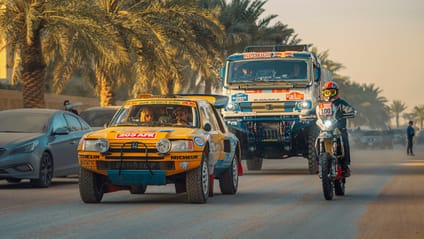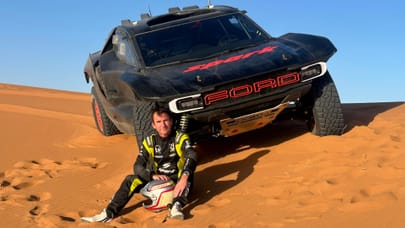
Behind the scenes at the 2022 Dakar Rally
Want to know how the tortuous rally raid/travelling circus is run? Step this way


You think the Dakar Rally is all about cars charging flat out over deserts and leaping over sand dunes. But that’s just the part you see. The part you don’t see is even more fascinating. Because Dakar isn’t so much a race as a travelling circus.
Photography: Mark Riccioni/Matt Vosper
Advertisement - Page continues below
Welcome to the bivouac, the beating heart of the Dakar. Each day as the 550 cars, bikes, quads, trucks, buggies and classics sally forth to take on the Saudi scenery, everything else ups sticks and moves ready to meet them at the other end.

And we’re not talking about a few support trucks and a bag of wrenches. The bivouac is home to over 3,000 people, it’s the size of a small town, with all (OK, most of) the associated amenities. Catering, showers, electricity, water, medical support, waste disposal, satellites, TV production – everything travels about on trucks and has to be broken down and reassembled almost every day. This was the Riyadh bivouac on the outskirts of the city, hence the backdrop of buildings. Usually the bivouacs are a lot more remote than this.
Advertisement - Page continues below
This year there were relatively few bivouacs – just six across 13 stages and two weeks of racing. When the rally was held in South America (2009-2019) the organisers (the ASO, the same firm that runs the Tour de France bike race) had two complete bivouacs that leapfrogged each other. But the race is now shorter (two weeks rather than three) and bigger (thanks in part to the addition of Dakar Classic last year, entrants have grown from under 400 to over 550).

This is Christophe Puginier, head of logistics for the whole event. He’s basically the man that makes Dakar work. The statistics are boggling. His job includes marshalling two ships, three planes, 15 helicopters, 100 trucks and 500 staff. That’s just what it takes to run the event. Then there’s the teams. That’s another 2,500 people and 1,400 vehicles. Every day all those people have to be fed three meals, have somewhere to sleep, work and so on.

Sleeping happens, well, anywhere. The bigger teams have roof tents on top of their support trucks. Everyone else just throws pop-up tents on a spare bit of dirt. The drivers and senior team bods have camper vans.

I know this isn’t a great shot of a camper van (there were always more interesting things to take pictures of) but we need to talk about them. Trucks got into the race originally because they were racing each other to get to the next bivouac first and the organisers realised they might as well incorporate them. We spoke to a couple of people who suggested, only semi-jokingly, that camper vans should be the next thing in. Why? Because in the quest to bag the best spot at the next bivouac, the camper vans are the easiest to pack up and send away first. Which has of course become competitive. Rumour has it that some team mechanics might have ‘fettled’ their vans to the extent that the fastest machine in this year’s Dakar wasn’t actually taking part in the rally at all…
Advertisement - Page continues below
Here’s where everyone eats, a giant marquee in the centre of the bivouac that serves upwards of 8,000 meals every day. All the food is sourced locally (a shift from a few years ago when I visited the race in Argentina and was proudly told that enough French wine and cheese had been sent along for every person to have a glass or two and a cracker every night). The tent takes 10 days to erect and dismantle, so this year the ASO has hired six of these and erected one as the centre-point at each bivouac.

Here’s the inside. The efficiency in processing people is extraordinary. And the food is good. And there’s plenty of it. Outside there’s a bar (not forgetting the fact Saudi is a dry country), a stage, video screens, a firepit, an interview booth, ranks of smaller marquees for the organisers, medics, race officials, media and so on.
Advertisement - Page continues below
The whole bivouac occupies 50 acres and it’s mostly pretty high density. This is the most compressed part, right next to the catering marquee. It’s the solo bike riders – people doing it unsupported. There’s lots of mutual assistance going on, but also titanic amounts of exhaustion.

The whole encampment is secure and enclosed – you can’t just walk in (although given the length of the perimeter it wouldn’t be difficult to break in). Once inside everything is open and friendly – you’re free to roam and nose about, people love to chat and everyone’s got stories to tell.

Here’s Audi’s encampment, the only one that actively tried to dissuade people from having a nose around. A hangover from their Le Mans mentality I suspect – although they could equally claim the RS Q e-tron’s high voltage electronics mean they have to keep people back.

Because Saudi is dry and dusty, they actually wet the main routes through the bivouac, but you can’t escape the dust – especially at night when the race vehicles return and the teams use air hoses to blast everything clean

This is the place I kept going back to. Well, you would, wouldn’t you. A Peugeot 205 T16 Dakar and a Peugeot 404 van that underneath is actually an ex-Dakar Mitsubishi Pajero. The Dakar Classic cars were the most captivating in the whole bivouac.

This is a typical picture. The cars come back from the stage wounded. Then the mechanics set to work with welders, angle grinders, spanners and hammers. The whole place buzzes to the noise of generators, air hoses, drills and tools.

Some jobs are bigger than others. This is the gearbox from a truck. It took four men just to set it upright.

In the afternoon the roads around the bivouac are a chaotic mix of vehicles heading for refuelling, shakedown runs after repairs, returning from stage. It’s brilliant mayhem.
Trending this week
- Car Review
BMW iX3







